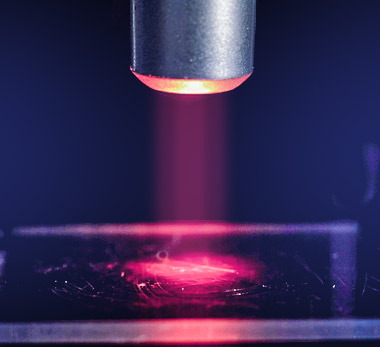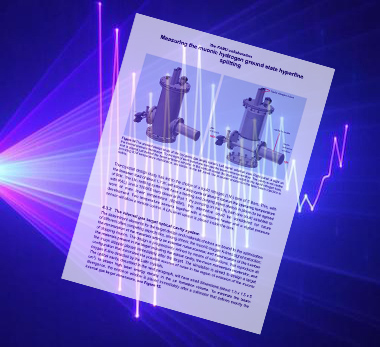FAMU
Goals
FAMU - Fisica degli Atomi MUonici - Muonic Atom Physics
FAMU is an international collaboration involving 13 institutions and about 30 scientists.
The goal of the FAMU experiment is the measurement of the proton Zemach radius with the measurement of the hyperfine splitting of the muonic hydrogen ground state.
This measurement is motivated by the interest to deeply understand the electromagnetic structure of the proton; a new result can give a boost to resolve the present ambiguities about its structure. Moreover the FAMU experiment can be seen as a precision QED theory test.
The experimental apparatus consists in a cryogenic and pressurized gas target, filled with a gas mixture of hydrogen and a small concentration of a high Z gas.
The target is surrounded by X-ray detectors.
The experiment is placed at the RIKEN-RAL muon facility where a high intensity muon beam is produced.
Counting the number of the X-rays emitted by the de-excitation of the Z atom as function of various laser energies it is possible to obtain a resonance plot peaked at the hyperfine energy value.
FAMU has developed a laser system that is unique
Insights
Investigating the Proton Structure: The FAMU Experiment (Nucl Phys. News 2023) Download manuscript (pdf)
The FAMU experiment (EPJ 2020)
MENPHYS
MENPHIS, MEtrology and Nonlinear optics for Precision muonic HYdrogen physicS, is a project designed to improve the laser system and
the absolute calibration procedure of the laser of FAMU. The project has been financed within the frames of an
Italian national research call (PRIN2022).
MENPHYS will strengthen the potentials of the FAMU
experiment by upgrading significantly the laser system; simplifying the coupling of the laser light into
the optical cavity around the muon beam line; increasing the accuracy in the determination of the
transition frequencies used as calibration standards of the excitation laser.
Work with us
Working in FAMU is an opportunity for an inclusive experience: it is an international collaboration (Italy, Bulgary, Poland, Japan, India, and China) yet small enough to allow and encourage its members to work on a wide range of activities. From setting up the detectors before an acquisition run, to deeply understand the various aspect of the experiment, ranging from the hardware to the physics aspect and to most theoretical point of view; not to forget the laser and its development.
FAMU
Collaboration

INFN Trieste
Elettra- Sincrotrone
ICTP
INFN Bologna
INFN Milano Bicocca
INFN Pavia
INFN Roma3
INFN Napoli - Università degli studi della Campania Luigi Vanvitelli
INFN – GSSI
RIKEN-RAL
INP, Polish Academy of Sciences
INRNE, Bulgarian Academy of Sciences
Dalian Institute of Chemical Physics of the Chinese Academy of Sciences
People

FAMU Members and former members
E. Mocchiutti (INFN Trieste) , A. Adamczak (Cracow, INP), D. Bakalov (Sofiya, Inst. Nucl. Res.), G. Baldazzi (INFN Bologna), R. Benocci (INFN Milan Bicocca, Milan Bicocca U.), R. Bertoni (INFN Milan Bicocca), M. Bonesini (INFN Milan Bicocca, Milan Bicocca U.), V. Bonvicini (INFN Trieste), H. Cabrera Morales (INFN Trieste), F. Chignoli (INFN Milan Bicocca), M. Clemenza (INFN Milan Bicocca, Milan Bicocca U.), L. Colace (INFN Rome3, Rome III U.), M. Danailov (INFN Trieste, Sincrotrone Trieste), P. Danev (Sofiya, Inst. Nucl. Res.), A. de Bari (Pavia U., Dept. Fis. 'A. Volta' , INFN Pavia), C. De Vecchi (INFN Pavia), M. De Vincenzi (INFN Rome3, Rome III U.), E. Fasci (INFN Napoli), E. Furlanetto (INFN Trieste, Udine U.), F. Fuschino (INFN Bologna, IASF Bologna), K.S. Gadedjisso-Tossou (INFN Trieste, ICTP, Trieste & U. Lome), L. Gianfrani (INFN Napoli), D. Guffanti (INFN Trieste, L'Aquila U.), K. Ishida (Nishina Ctr., RIKEN), C. Labanti (INFN Bologna, IASF Bologna), V. Maggi (INFN Milan Bicocca, Milan Bicocca U.), R. Mazza (INFN Milan Bicocca), A. Menegolli (Pavia U., Dept. Fis. 'A. Volta' , INFN Pavia), L. Moretti (INFN Napoli), G. Morgante (INFN Bologna, IASF Bologna), M. Nastasi (INFN Milan Bicocca, Milan Bicocca U.), J. Niemela (ICTP Trieste), C. Pizzolotto (INFN Trieste), A. Pullia (INFN Milan & Milan U.), R. Ramponi (INFN Milan), L.P. Rignanese (INFN Bologna), M. Rossella (INFN Pavia), N. Rossi (Udine U.), R. Rossini (INFN Pavia, Pavia University, ISIS),A. Sbrizzi (INFN Bologna), M. Stoilov (Sofiya, Inst. Nucl. Res.), L. Stoychev (INFN Trieste, ICTP), L. Tortora (INFN, Rome3), E. Vallazza (INFN Milano Bicocca), G. Zampa (INFN Trieste), A. Vacchi (INFN Trieste, Udine U. & Nishina Ctr., RIKEN))
E. Mocchiutti (INFN Trieste) , A. Adamczak (Cracow, INP), D. Bakalov (Sofiya, Inst. Nucl. Res.), G. Baldazzi (INFN Bologna), R. Benocci (INFN Milan Bicocca, Milan Bicocca U.), R. Bertoni (INFN Milan Bicocca), M. Bonesini (INFN Milan Bicocca, Milan Bicocca U.), V. Bonvicini (INFN Trieste), H. Cabrera Morales (INFN Trieste), F. Chignoli (INFN Milan Bicocca), M. Clemenza (INFN Milan Bicocca, Milan Bicocca U.), L. Colace (INFN Rome3, Rome III U.), M. Danailov (INFN Trieste, Sincrotrone Trieste), P. Danev (Sofiya, Inst. Nucl. Res.), A. de Bari (Pavia U., Dept. Fis. 'A. Volta' , INFN Pavia), C. De Vecchi (INFN Pavia), M. De Vincenzi (INFN Rome3, Rome III U.), E. Fasci (INFN Napoli), E. Furlanetto (INFN Trieste, Udine U.), F. Fuschino (INFN Bologna, IASF Bologna), K.S. Gadedjisso-Tossou (INFN Trieste, ICTP, Trieste & U. Lome), L. Gianfrani (INFN Napoli), D. Guffanti (INFN Trieste, L'Aquila U.), K. Ishida (Nishina Ctr., RIKEN), C. Labanti (INFN Bologna, IASF Bologna), V. Maggi (INFN Milan Bicocca, Milan Bicocca U.), R. Mazza (INFN Milan Bicocca), A. Menegolli (Pavia U., Dept. Fis. 'A. Volta' , INFN Pavia), L. Moretti (INFN Napoli), G. Morgante (INFN Bologna, IASF Bologna), M. Nastasi (INFN Milan Bicocca, Milan Bicocca U.), J. Niemela (ICTP Trieste), C. Pizzolotto (INFN Trieste), A. Pullia (INFN Milan & Milan U.), R. Ramponi (INFN Milan), L.P. Rignanese (INFN Bologna), M. Rossella (INFN Pavia), N. Rossi (Udine U.), R. Rossini (INFN Pavia, Pavia University, ISIS),A. Sbrizzi (INFN Bologna), M. Stoilov (Sofiya, Inst. Nucl. Res.), L. Stoychev (INFN Trieste, ICTP), L. Tortora (INFN, Rome3), E. Vallazza (INFN Milano Bicocca), G. Zampa (INFN Trieste), A. Vacchi (INFN Trieste, Udine U. & Nishina Ctr., RIKEN))







